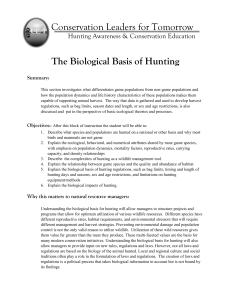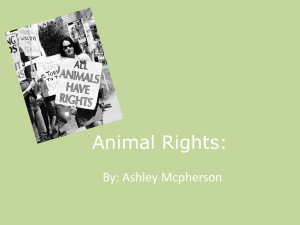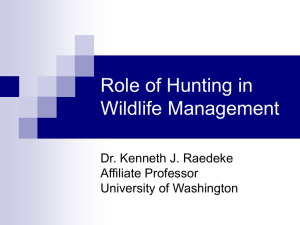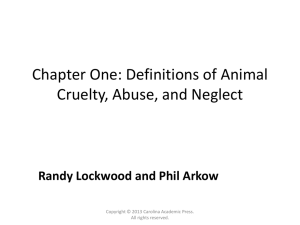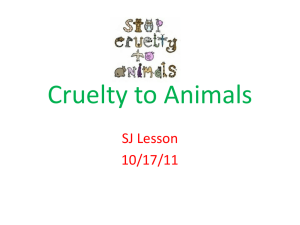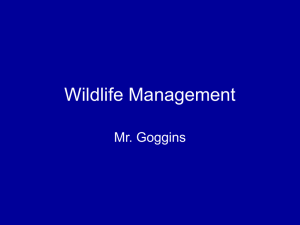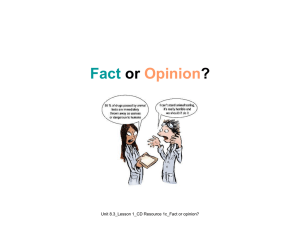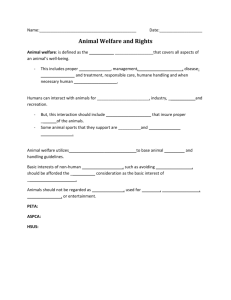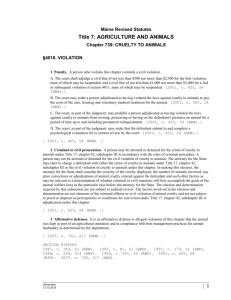presentation PPT
advertisement
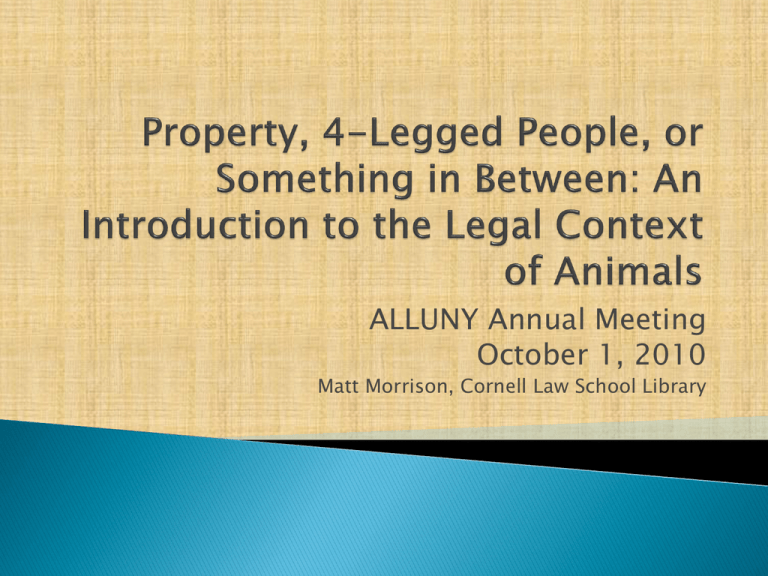
ALLUNY Annual Meeting October 1, 2010 Matt Morrison, Cornell Law School Library Animal Law Defined Animal Categories and Areas of Law Legal History Developments Sources The National Anti-Vivisection Society defines animal law as: “any legal issue that involves animals.” They further state, “it is a combination of statutory and case law in which the nature of non-human animals, whether legal, social or biological, is an important factor.” Agricultural— Livestock Companion—Pets Wildlife—Roaming the environment Entertainment animals Laboratory animals LIVESTOCK: Cattle, Horses, Sheep, Chickens, etc COMPANION: Dogs, Cats, Horses, Gerbils, etc WILDLIFE: Lions, and Tigers, and Bears (oh my..) Our Main Categories With Examples Rodeo Racing Zoos and Exhibitions Circuses Staged Fights Hunting Entertainment Research, Testing, Experimentation Cosmetics, Medicine Toxicity testing, Dissection Laboratory Animal Law intersects with: ◦ ◦ ◦ ◦ ◦ ◦ ◦ ◦ Torts Property/Estates and Trusts Commercial Law Family Law Criminal Law Environmental Law Sports & Entertainment Law Constitutional Law Dog bites Nuisance and property damage Vet malpractice Torts Ownership and transfer of ownership Patents Pet trusts Property/Estates and Trusts Contract disputes ◦ Buyers/Sellers ◦ Performance Animals Dealings with vets, kennels, etc (bailment) Agriculture and food production Product testing Commercial Law Pet custody battles Pets involved in prenups and divorce settlements Family Law Anti-cruelty statutes ◦ Abuse, dog fighting, vivisection Protective orders Defense of animal advocates Criminal Law Endangered species protection Protection of habitat— clean water Public lands management (wild horses, etc) Environmental Law Criminal Law… Environmental Law… Racing Animal Welfare— circuses and exhibitions Hunting—regulation of methods, species hunted, places where hunting occurs. Sports & Entertainment Law First Amendment protection of animal rights activists Freedom of Religion— animal sacrifice, vegan diets of prisoners or workers. Fourth Amendment issues when police shoot or confiscate pets. Constitutional Law Deep Roots Nuisance—the hog farm Strict Liability: for trespass by livestock, esp onto crop fields Livestock Auctions and Sales Slaughter Regulation: Slaughtering was done just off Wall St in NYC, but then ordered outside of city in 1676! Early laws addressed cruelty First recorded prohibition of cruelty was in 1641 in the Massachusetts Bay Colony ◦ Body of Liberties: “No man shall exercise any tirranny or crueltie towards any bruite creature…” ◦ Evolved from old English malicious mischief laws, or perhaps public nuisance law 1800 saw attempts in England to ban bullbaiting In 1822, the Ill Treatment of Horses and Cattle Bill was approved in England. Hunting and Property: Pierson v Post ◦ Famous 1805 property case from NY in which rights to a hunted fox were in dispute. Court ruled that giving chase was insufficient to bestow right. But dissent disagreed saying hunters should be encouraged to rid countryside of “noxious beast[s]” In late 1800’s Supreme Court upheld CT law regulating transport of game birds against Commerce Clause challenge. In 1900, Congress passed Lacey Act prohibiting interstate trafficking in birds killed/captured in violation of state law. Federal-State Tension Hunting: English laws date to the 1300s and were geared toward maintaining privilege and prevention of depletion American hunting law came later, although Virginia est’d a deer season in 1646. Circuses/exhibitions were largely unregulated until the Animal Welfare Act of 1970. Rodeos and livestock are excluded from the AWA. Bull-baiting was banned in England in 1822. Racing: exempt from the AWA; wagering regulated starting in 1870s. Began in 1870s England A physiologist’s lab assistant was disturbed by what he saw and publicized the conditions. Royal Commission on Vivisection was established with Queen’s backing. Cruelty to Animals Act of 1876 was passed regulating vivisection and licensing labs. Americans took note, states began regulating. Animals have been, and still are, regarded as property. This notion intertwined with agrarian societies to benefit humans, and the law reflected this. Bolstered by philosophy, tradition, and pragmatism: ◦ “Animals have no souls or minds” ◦ “We’ve always used them” ◦ “And using them works” Legal Development Where we came from… Property rights shaped both the legal context of animals and human attitudes. But, English jurist Jeremy Bentham was a catalyst for change in the 19th century. He wrote: “The question is not, Can they reason? Can they talk? But can they suffer?” Legal Development Views began to change… The Ill Treatment of Horses and Cattle Bill of 1822 The Cruelty to Animals Act of 1876 In 1824, the Society for the Prevention of Cruelty to Animals was founded In 1840, Queen Victoria allowed the SPCA to use the prefix “Royal.” In the 1800s, Britain still had significant intellectual influence in the States. New York’s original anti-cruelty statute was in 1828. In 1866, the American Society for the Prevention of Cruelty to Animals was founded. In America… Some changes The National Anti-Vivisection Society states it this way: ◦ “the underlying philosophy of the law is this: that animals merit the protection of the law only if and to the extent that such protection will not interfere with the interests of humans, which are considered to have more importance than the interests of animals.” Humans: Unconditional protection Animals: Conditional protection based on human needs and desires The 20th century saw significant increase in anti-cruelty and animal welfare laws at the state and federal level. There are significant federal laws aimed at wildlife and the regulation of slaughter and the movement of animals in interstate commerce. While some underlying ideas have changed since 1800, many have not. Law Schools: ◦ Increasing number of animal law courses and seminars ◦ Increasing animal law clinics: Duke has a good one Practitioners: ◦ More state and local bars have animal law sections ◦ More attorneys are working on animal cases ASPCA National Anti-Vivisection Society Animal Legal Defense Fund American Humane Association Animal Welfare Institute Humane Society of the United States—their site provides solid coverage of federal and state statutes. World Wildlife Fund Animallaw.com Animal Blawg Animal Rights: The Abolitionist Approach Animal Legal and Historical Web Center (Michigan State) Animal Ethics Blog Center for Wildlife Law (UNM) Center for Animal Law Studies (Lewis & Clark) Pet-Abuse.com Animals and the Law: A Sourcebook, by Jordan Curnutt Animal Law: Cases and Materials, 4th ed., by Bruce A. Wagman, et al. Animal Law: Welfare, Interests, and Rights, by David Favre People, Property, or Pets?, by Marc D. Hauser, et al. ANIMAL LAW REVIEW (Lewis and Clark) JOURNAL FOR CRITICAL ANIMAL STUDIES JOURNAL OF ANIMAL LAW (Mich. St.) JOURNAL OF ANIMAL LAW AND ETHICS (Penn) STANFORD JOURNAL OF ANIMAL LAW AND POLICY


